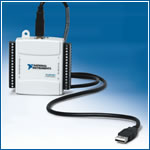USB for I2C and SPI
National Instruments has released a new USB device for use with inter-integrated circuit (I2C) and serial peripheral interface (SPI) communication devices.
National Instruments has released a new USB device for use with inter-integrated circuit (I2C) and serial peripheral interface (SPI) communication devices.
Engineers can use the new NI USB-8451 interface with NI LabVIEW software to create programs to test, validate and program devices such as analog-to-digital converters (ADCs) and EEPROMs.
Many consumer electronics such as DVD players and computer motherboards contain hundreds of components that work with each other and communicate through I2C or SPI. Previously, engineers often faced programming challenges when implementing I2C and SPI protocols for use with digital I/O boards. The new USB-8451 interface includes driver software that provides high-level, LabVIEW functions for developing applications without requiring in-depth knowledge of I2C and SPI communications.

In addition to providing both I2C and SPI communication, the new USB-8451 also includes eight digital lines for general-purpose I/O and is capable of full-speed USB connectivity. The USB-8451 interface is ideal for applications involving consumer electronics such as programming, testing and communicating with devices including LCDs, ADCs and sensors.
Hardware design engineers can use the USB-8451 interface to test and validate component prototypes. For example, engineers wanting to validate the functionality of a microcontroller that includes I2C or SPI communication lines no longer need to place the microcontroller on the printed circuit board (PCB) and hope that it interacts well with the other components. Instead, they now can send I2C or SPI commands to the microcontroller through the USB-8451 interface to validate its functionality before placing it on the PCB.
Register now to continue reading
Thanks for visiting The Engineer. You’ve now reached your monthly limit of news stories. Register for free to unlock unlimited access to all of our news coverage, as well as premium content including opinion, in-depth features and special reports.
Benefits of registering
-
In-depth insights and coverage of key emerging trends
-
Unrestricted access to special reports throughout the year
-
Daily technology news delivered straight to your inbox










Water Sector Talent Exodus Could Cripple The Sector
Maybe if things are essential for the running of a country and we want to pay a fair price we should be running these utilities on a not for profit...